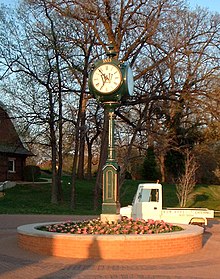Danforth Campus
Distinguished by its collegiate gothic architecture, the 169-acre (0.68 km2) campus lies at the western boundary of Forest Park, partially in the City of St. Louis.
At the fair's conclusion, the newly constructed buildings assumed their original functions as classrooms and administrative offices.
[3] Cope & Stewardson, a firm known for its mastery of Collegiate Gothic, designed Brookings Hall as a centerpiece of a new campus plan.
The plan, modeled after the distinctive quadrangles of Oxford and Cambridge Universities, has guided the construction and expansion of the Danforth Campus to the present day.
[4] In 1922, Arthur Holly Compton, a physics professor, conducted a series of experiments in the basement of Eads Hall that demonstrated the particle concept of electromagnetic radiation.
In the summer of 2002, Brookings Hall Room 300 was transformed into the Mission Control center for Steve Fossett's sixth and ultimately successful attempt to circumnavigate the planet in a balloon—the Spirit of Freedom.
All new buildings on the east end have been designed to achieve LEED-Gold certification and include solar panels on many of the roofs to generate renewable electricity.
Known as SU for short, it sponsors large-scale campus programs including WILD (a semesterly concert in the quad), free copies of The New York Times, USA Today, and the St. Louis Post-Dispatch through The Collegiate Readership Program; the Assembly Series, a weekly lecture series; and the campus television station, WUTV and the radio station, KWUR and Filmboard.
The university is home to one of the largest collegiate Relay For Life in the country, raising over $200,000 last year in total donations.
Greek Organizations are governed by the principles of Arete, which focuses on Integrity, Loyalty, Philanthropy, Responsibility, Friendship, and Intellectual Curiosity.
Recent resolutions of the Senate include improving Wi-Fi capabilities, improving relations between Alumni & Development and the Career Center, adding new capabilities to student ID cards, forming a LGBTQA task force, requiring all professors to distribute course syllabi and midterm grade progresses, and increasing the minimum wage of university workers.
[12] There is a large interest in A cappella music on campus, spawning groups such as After Dark, The Amateurs, The Aristocats, Deliverance, The Ghost Lights, The Greenleafs, More Fools Than Wise], The Mosaic Whispers, The Pikers, SensAsian, Staam, The Stereotypes, and Sur Awaaz.
Other student organizations, such as the Social Programming Board bring in popular musical acts for Walk In Lay Down and lesser-known independent performers.
In coming years, the university will be allowing upperclass students the option of mixed-gender housing, whereby any combination of males and females can live in the same suite if they so choose.
In addition to a Subway restaurant, nearly all locations are operated by the catering service Bon Appétit Management Company.
The dining location, known as Bear's Den, which includes stations such as the Cherry Tree Cafe (coffee and baked goods), Ciao Down (pasta and pizza), Grizzly Grill (burgers and other "American-style" food), WUrld Fusion (Indian inspired Global cuisine), L 'Chaim (fresh, Kosher meals), OSO Good (Mexican fare, such a tacos and burritos), and Sizzle & Stir (Mongolian-style stir-fry).
The Barry Flanagan bronze statue, Thinker on a Rock, widely known, simply, as "The Bunny", is currently on permanent loan to Washington University and features prominently near Olin Library, Graham Chapel and Mallinckrodt (Edison Theater).
The Mildred Lane Kemper Art Museum on campus houses most of the university's art and sculpture collections, including pieces by Jackson Pollock, Robert Rauschenberg, Jenny Holzer, Pablo Picasso, Max Ernst, Willem de Kooning, Henri Matisse, Joan Miró, and Rembrandt van Rijn, among others.











